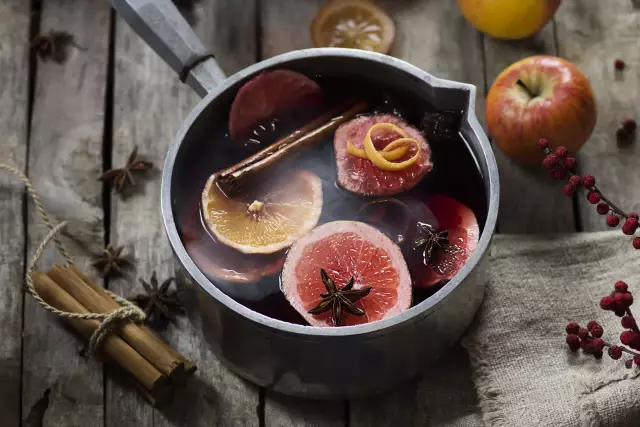Blanc de Noir
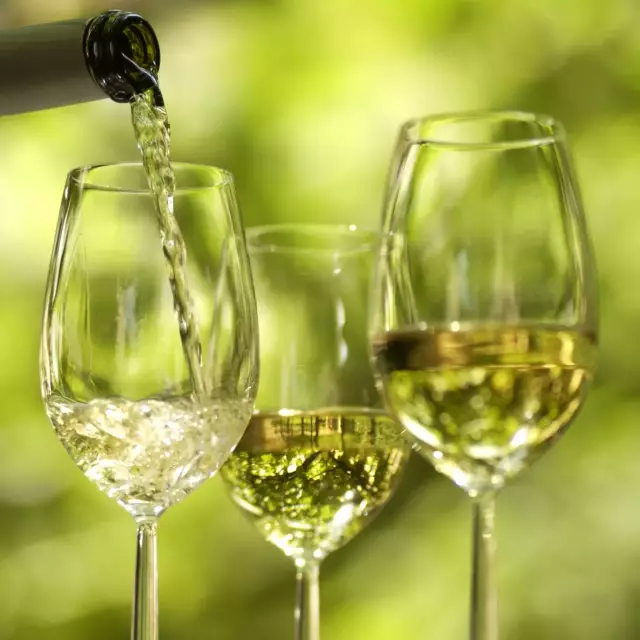
"White from black" - this is the literal translation of "Blanc de Noir" and stands for a white wine made from dark blue to black grapes.
Facts
-
100 %
red grapes
-
2021
was "Blanc de Noir" redefined in terms of wine law
As the name suggests, this form of winemaking has its origins in France, where the red grapes of Pinot Noir (Spätburgunder) and Pinot Meunier (Schwarzriesling) have always been processed into white wines as the basis for champagne.
This is possible because red berries generally have light flesh. The red pigment, the so-called anthocyanins, are mainly present in the berry skins. If the juice from red grapes is to remain white, no colourants from the skins may pass into the must. It is therefore important that the red grapes, which are as healthy as possible, are only pressed gently. The light colored must obtained is then fermented to a white wine. A typical Blanc de Noir has a light color and can sometimes have hints of yellow-gold.
If the cellar master leaves the squeezed red berries in the pressed juice for a little longer - the experts then speak of a longer "maceration time" – this is when a little more color passes from the skins into the must and a rosé develops.
In terms of wine law
After the 10th law amending the Wine Act came into force in January 2021, according to the new Wine Ordinance the designation "Blanc de Noir" or "Blanc de Noirs" may only be used for domestic wine, sparkling wine, quality sparkling wine or semi-sparkling wine if it is a product with a protected designation of origin (PDO) is made from fresh red wine grapes like a white wine and has the typical color of white wine.
Why Blanc de Noir?
The white wines obtained from the red grapes are characterized by their distinctive fruit aromas, pleasant freshness and moderate acidity. They combine the full flavor of a red wine with the fruitiness of a white wine and thus display the characteristics of both types. Blanc de Noirs are excellent food companions that go well with a wide range of dishes.
Flexibility and positive side effects
For winemakers who mainly cultivate red grape varieties, the production of Blanc de Noirs is also an opportunity to react flexibly to the increasing demand for white wine. On the other hand, there is a positive side effect for the production of red wine: if the light-colored must for a Blanc de Noir is removed before the maceration, the ratio of the color and tannin-containing skins to the remaining pressed juice in the mash changes. As a result, winemakers and wine lovers can enjoy more complex and color-intensive red wines.
How is Blanc de Noir defined under wine law in Germany?
According to the Wine Law, the name "Blanc de Noir" or "Blanc de Noirs" may only be used if it is a product with a protected designation of origin (PDO), pressed from fresh red grapes like a white wine and with the color typical of white wine.
Varietals

More recipe ideas
with pear wedges Chicken breast strips
with pear wedges
- 500 Gramm Hähnchenbrustfilet
- 2 reife Birnen
- 200 ml Birnensaft
- 100 ml Sahne
- 1 ganze Zwiebel
- 4 EL Olivenöl
- nach Belieben Salz & Pfeffer
Cut the chicken breast fillet into strips. Peel the onion and cut into cubes. Heat the olive oil in a pan and fry the meat in it. Add the diced onion and season with salt and freshly ground pepper.
Wash and peel the pears, remove the skin, cut into wedges and sauté in the pan. Deglaze with the pear juice and allow to reduce slightly.
<p
<p>Finally, add the cream and season to taste.
- Müller-Thurgau (halbtrocken & feinherb)
- Kerner (halbtrocken & feinherb)
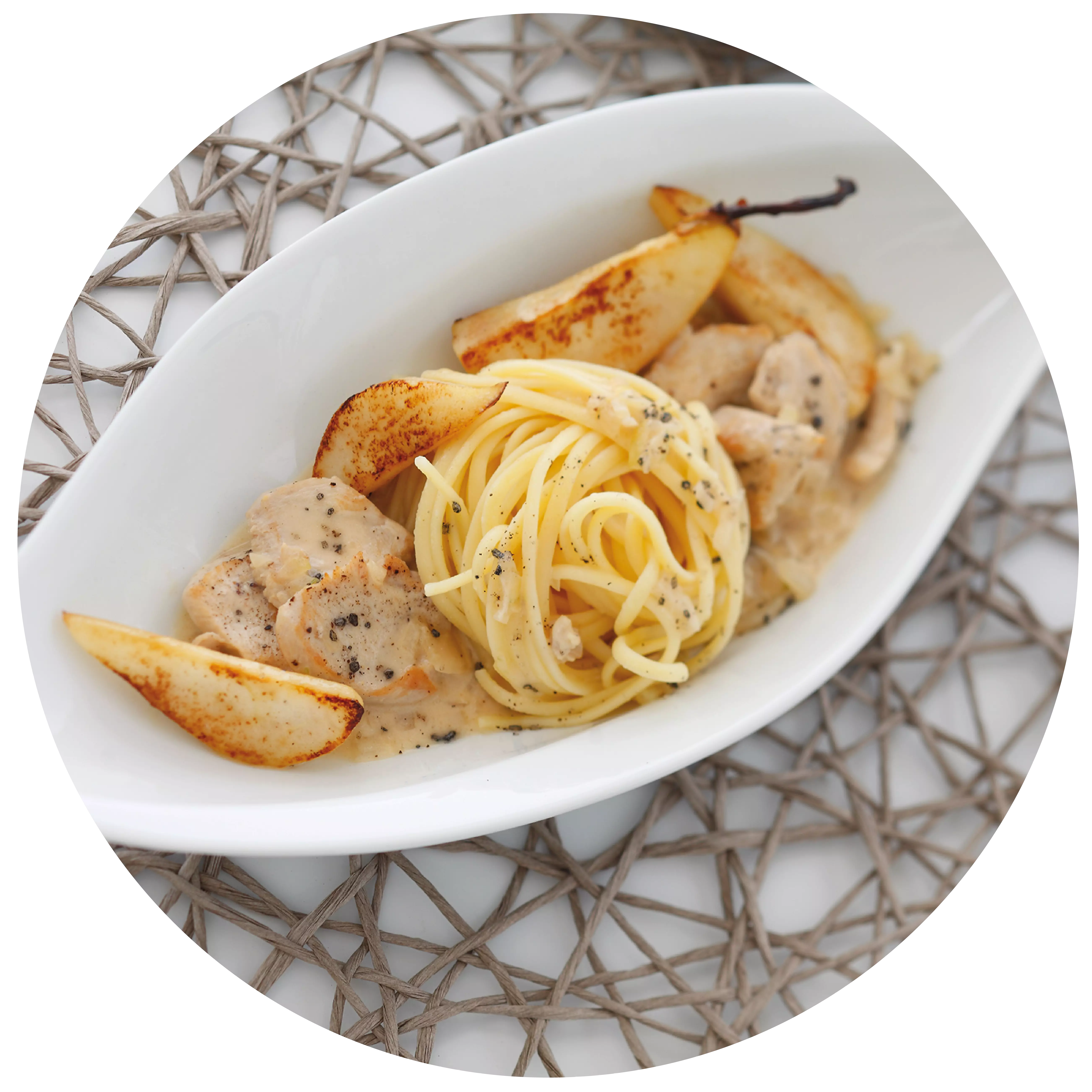
with wild duck breast, porcini mushrooms and glazed chestnuts Herb salad
with wild duck breast, porcini mushrooms and glazed chestnuts
- 150 Gramm Wildkräuter
- 4 EL Olivenöl
- 2 EL Balsamessig
- 8 Stück Wildentenbrüste (a 100g)
- 2 EL Sonnenblumenöl
- 4 EL Honig
- 1 EL Thymian
- 200 Gramm Steinpilze
- 20 gekochte Maronen
- 100 ml Apfelsaft
- 2 El Zucker
- nach Belieben Salz & Pfeffer
Clean, wash and pat dry the wild herbs. Marinate with olive oil and balsamic vinegar and season with salt and pepper.
Preheat the oven to 220°C top and bottom heat. Season the wild duck breasts with salt and pepper, sear on the meat side in a pan with sunflower oil and cook in the preheated oven for about 8 minutes on the skin side. Remove the duck breast, brush the skin side with honey and thyme and roast for another 2 minutes on a high heat until crispy.
Clean the porcini mushrooms and cut into slices. Fry in a pan in oil on both sides, remove and keep warm. Caramelise the sugar in the pan, deglaze with the apple juice and simmer until the caramel has dissolved. Add the chestnuts and add a little more apple juice if necessary.
- Pinot Blanc (trocken)
- Gutedel (trocken)
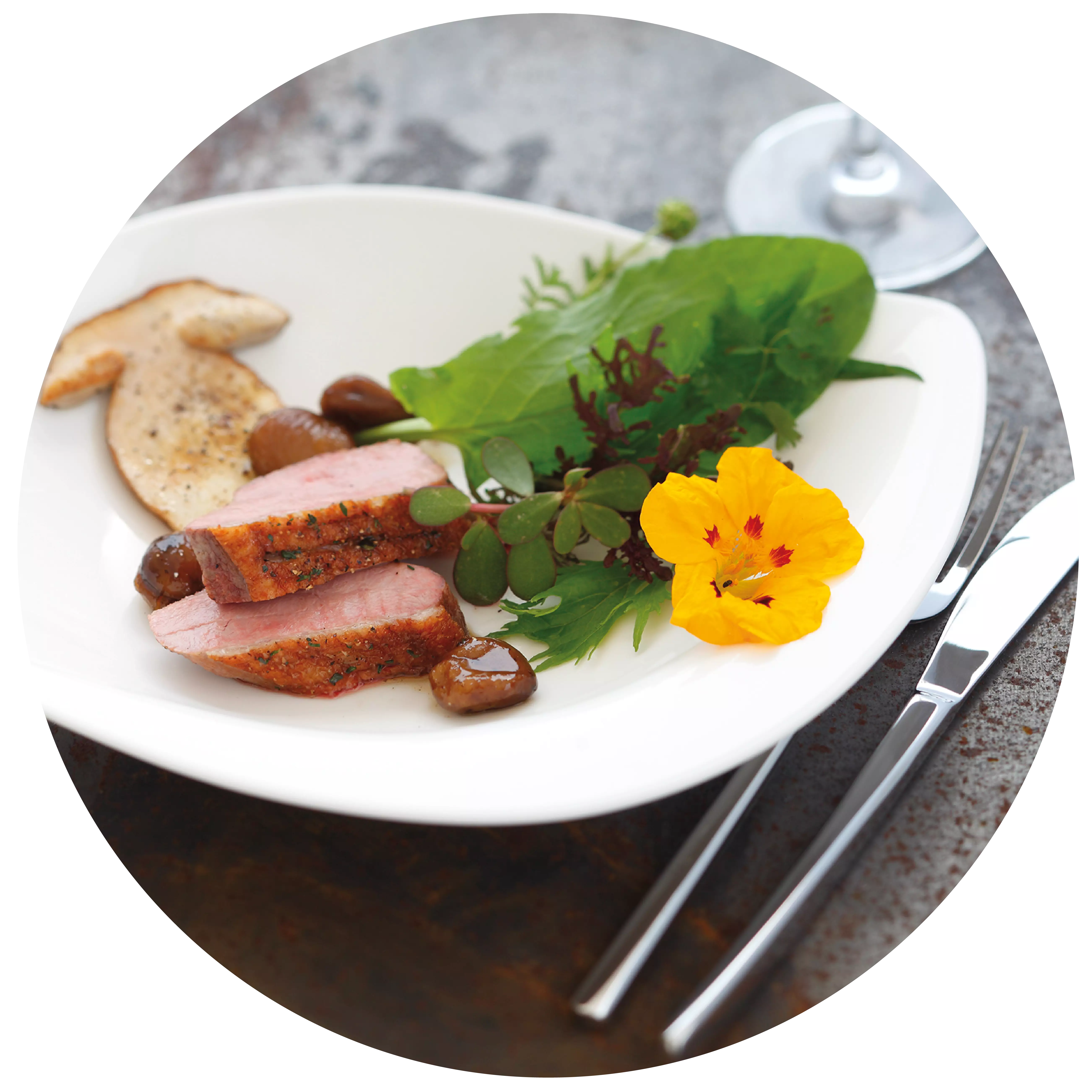
with white wine Cauliflower soup
with white wine
- 3 Stück Schalotten
- 500 Gramm Blumenkohl
- 20 Gramm Butter
- 1 TL Fenchelsaat
- 50 ml Weißwein
- 800 ml Gemüsebrühe
- 100 ml Schlagsahne
- 1 Prise Zucker
- nach Geschmack Salz & Pfeffer
Peel the shallots and cut into slices.
Clean and chop the cauliflower.
Melt the butter in a pan, sauté the shallots with the fennel seeds over a medium heat for 3 minutes until colourless. Add the cauliflower, sauté for 2 minutes, season with salt and sugar.
<p
<p>Deglaze with white wine, bring to the boil and top up with vegetable stock and whipping cream. Simmer over a low heat for 20 minutes.
Blend with a hand blender, adding stock if necessary to reach the desired consistency.
Serve drizzled with a few drops of olive oil.
- Silvaner (trocken)
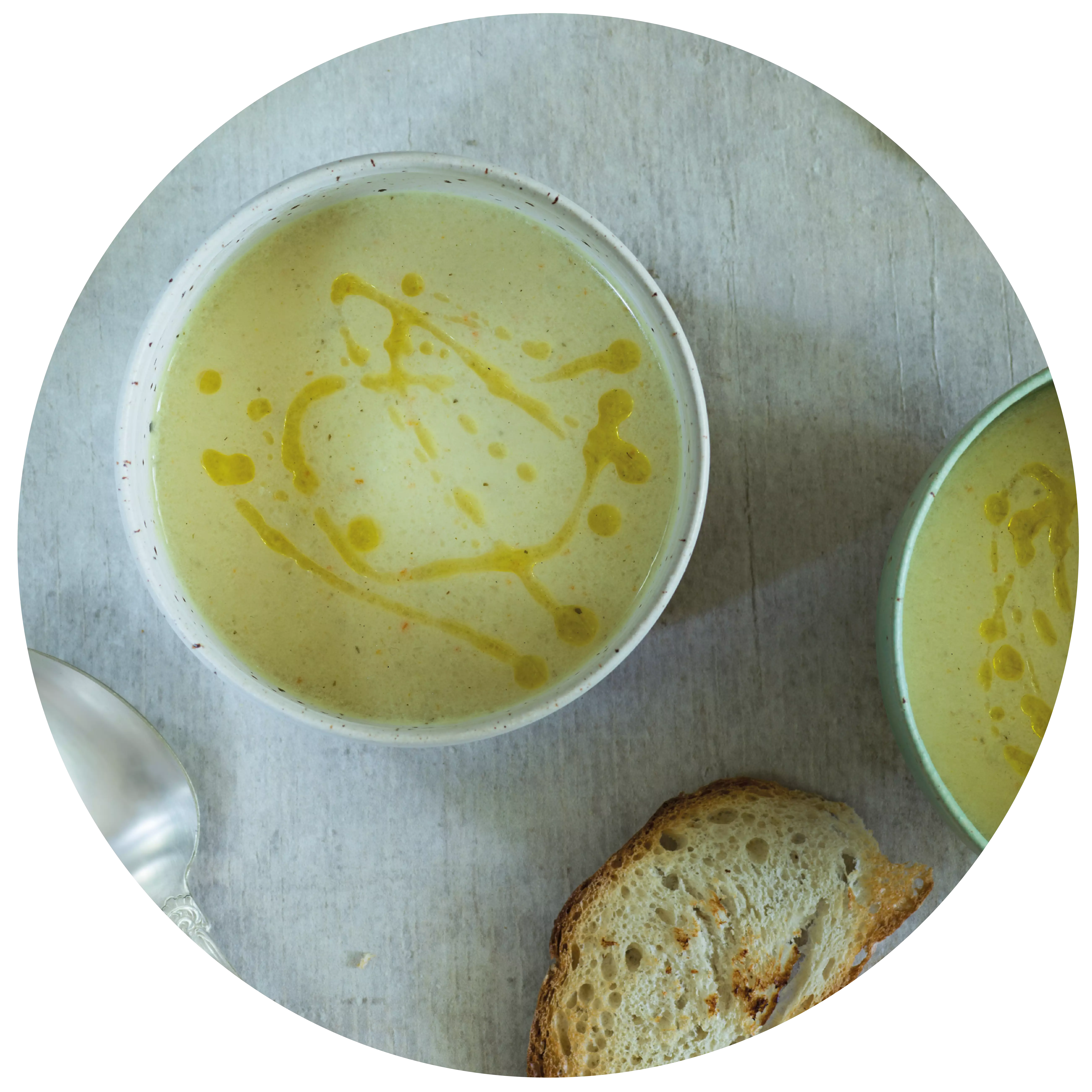
with semi-dry wines Flädlesuppe
with semi-dry wines
- 1 Bund Schnittlauch
- 1 Liter Fleischbrühe
- 150 Gramm Weizenmehl
- 300 ml Milch
- nach Belieben Speckschwarte zum ausreiben der Pflanne
- Etwas Salz
Make a smooth, not too thick batter from the flour, milk, eggs and a pinch of salt. Heat a heavy frying pan on a high heat, rub with bacon fat, pour in a small dollop of batter, allow to spread and fry thin pancakes (flädle).
<p
<p>Leave the pancakes to cool, halve and cut into thin strips.
Place in clear, very hot meat stock and serve immediately.
<p- Trollinger (halbtrocken & feinherb)
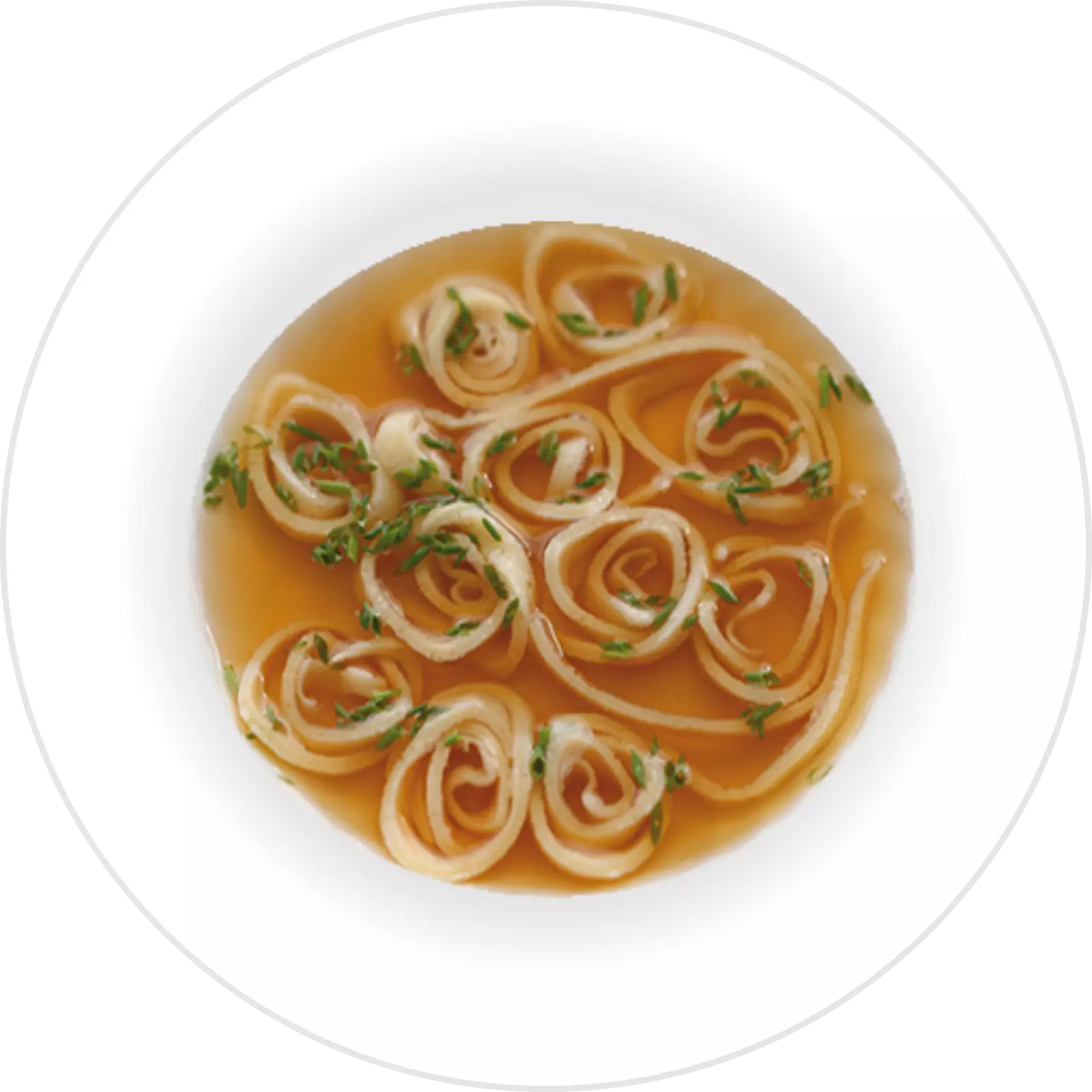
Events
-
Show
winetasting in our winery - blind tasting
Mainz-Hechtsheim




